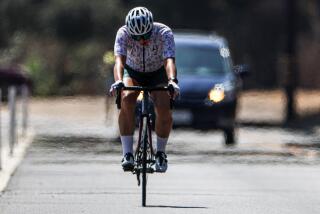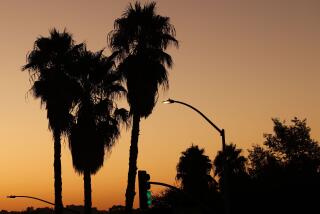Heat Leaves Thousands Powerless
Overloaded by unrelenting power demand, hundreds of electrical transformers failed throughout the Los Angeles area Sunday, triggering widespread and unpredictable power outages that compounded people’s misery during one of the region’s worst heat waves on record.
Roughly 175,000 households and businesses lost power Sunday, mainly in sweltering inland communities where temperatures remained stubbornly high. Records for the date were broken in Woodland Hills at 108 degrees; Pasadena, 107; downtown Los Angeles, 97; and UCLA, 93. Humidity soared and thunderstorms rumbled through beach cities, intensifying the feel of the heat.
For the record:
12:00 a.m. July 28, 2006 For The Record
Los Angeles Times Tuesday July 25, 2006 Home Edition Main News Part A Page 2 National Desk 1 inches; 45 words Type of Material: Correction
Power outages: An article in Monday’s Section A about power outages in the Southland said electrical transformers transfer power, converting it to lower wattages that can be routed down lines and into homes and businesses. In fact, transformers convert power to lower voltages, not wattages.
For The Record
Los Angeles Times Friday July 28, 2006 Home Edition Main News Part A Page 2 National Desk 1 inches; 41 words Type of Material: Correction
Power outages: An article in Monday’s Section A about power outages in the Southland said that the 76 degrees recorded Saturday night was the warmest night ever recorded in downtown Los Angeles. It was the warmest night recorded for that date.
The heat wave was blamed for at least two deaths Sunday in Northern California, including one that triggered a criminal investigation of a Stockton nursing home. The Bay Area was also hit hard by power outages.
Inside their hot Los Angeles-area homes, residents without power fumed when they could not get through by phone to overwhelmed utility companies.
“I feel that if they can’t provide power, at least they could provide information,” said Cynthia Bowie, whose home lost power Friday evening and was still dark Sunday night. She said she had not been able to get any information from Edison. “We just have no idea what we’re dealing with.... Has Edison lost control of the power situation?”
A spokesman said the company had been swamped by phone calls and could not respond immediately.
“We are having a large number of people without service throughout the Southland, all related to the weather, the heat, the humidity,” said Edison spokesman Steven Conroy. “We are seeing record consumption, record temperatures, and when operated at high use continually, there is a chance of equipment failure, and that’s what’s happening today.”
Some of those without electricity lounged on shaded porches, while other adults unabashedly soaked in children’s wading pools and sucked on popsicles. A few even purchased their own generators. All had struggled with overnight heat without power for even a fan.
“I had a terrible night. Everyone did,” said Dona Nicoloff of West Hollywood, whose neighborhood was without power for about 26 hours beginning Saturday afternoon. “We’ve had outages before. You expect it in this kind of weather, but not for this long.”
The Sunday morning postings on the popular My Space.com website -- knocked down for hours during an outage that hit its Santa Monica headquarters -- revealed a new category of electricity failure frustrations:
“Everyone I know went thru withdraws w/that power outage,” one member posted in spelling-error shorthand.
Sunday was the 18th consecutive day that temperatures reached triple digits in parts of the Los Angeles Basin. The National Weather Service issued yet another warning of “dangerous heat and humidity” across most of Southern California, triggered by moisture from monsoonal conditions combined with an extra-strong ridge of high pressure that refused to budge.
A slight cooling trend was expected to begin today, with partly cloudy skies and temperatures in the 80s and 90s.
Sunday’s statewide electricity consumption was lower than expected, thanks to slightly less-broiling temperatures.
But power operators are bracing for a surge in demand as offices and stores open for the workweek. State officials warned of the possibility of record-breaking peak usage and rolling brownouts today.
“We don’t want to overly scare anyone, but conservation is going to be absolutely critical,” said Gregg Fishman, a spokesman for the California Independent System Operator, which manages power transmission in most of the state.
A low state energy supply was not the source of the power outages Sunday, despite a Stage One power emergency.
Instead, the equipment that routes the power, primarily transformers, became overwhelmed in San Gabriel foothill communities, Long Beach, the San Jacinto Valley and elsewhere.
Basic technology invented more than a century ago, transformers quietly and efficiently plug away at their jobs most of the time. But after toiling 24 hours a day, seven days a week during the Southland’s recent record-breaking heat, many simply lost their cool.
Among the simplest of electrical devices, transformers are vital because they transfer power, converting it to lower wattages that can be routed down lines and into homes and businesses.
Some transformers started smoking. Others shut down automatically to prevent a fire. Many just stopped working.
“The demand is just too great,” said Los Angeles Department of Water and Power spokeswoman Gale Harris. “Although we have adequate power supply, there’s tremendous demand on the system all at once.”
Simply put, it was too hot for too long. Like a radiator in a car, a transformer can take only so much before it overheats.
Unlike typical Southern California conditions, evenings have not cooled off much. People have kept their air conditioners on, further straining the equipment. Although designed to withstand high temperatures, transformers have their breaking point.
“We’re not seeing any cooling down at night. The transformers are really running hard, so they are not given an opportunity to cool down,” Conroy said.
In downtown Los Angeles the temperatures never fell below 76 degrees Saturday night, the warmest night ever recorded there.
An estimated 145,000 of Edison’s 13 million customers lost power between Saturday afternoon and Sunday afternoon. In addition, outages affected 30,000 DWP customers. Although the numbers were large, only 1% of the utilities’ customers were affected.
Some customers lost power for longer than 24 hours, while other outages lasted only a few minutes. Power companies scrambled to dispatch about 400 workers to about 600 overloaded transformers. Ron Deaton, DWP’s general manager, said Sunday that crews were expected to have all systems repaired by tonight.
In Stockton, two patients from Beverly Healthcare Center were admitted to a hospital with heat-related symptoms. One died and the other was in critical condition.
Stockton Police Sgt. Eric Ingersoll said officials discovered that although the nursing home hadn’t lost power, the air conditioning had been out “at least a day. It was every bit as hot as it was outside,” prompting an investigation into the possibility of negligence. Emergency officials worked through the night to evacuate more than 100 other residents to hospitals.
Sunday’s statewide power usage peaked at just under 46,000 megawatts, less than Friday’s record 49,036 megawatts. But today’s usage is predicted to break that record, reaching 50,000 megawatts.
“We may get into a Stage One power emergency, possibly Stage Two,” Fishman said, adding that a Stage Three alert, which would trigger rolling brownouts, “is in the realm of possibility.”
The combination of brutal heat and unusually strong thunderstorms befuddled many.
Late Sunday morning, thunderstorms drenched the coast from Huntington Beach to Manhattan Beach, turning colorful sand umbrellas into rain shelters.
“At about 11 a.m. it went from a drizzle to a torrential downpour, and we had up to 30-knot winds,” said Los Angeles County Lifeguard Capt. Mike Inscore. “We’re not Florida lifeguards, and my guards were asking me what to do because there were lightning strikes on the water, and I said, ‘Clear the beach.’ ”
Once the storm passed, the sun popped out and people slowly started to return.
A lifeguard working at a water park in Buena Park who suffered a burn to her hand may have been hit by lightning.
Mayor Antonio Villaraigosa urged Los Angeles residents to cut their power usage.
In overheated Woodland Hills, residents scoffed.
“I have to use my air conditioner 24-seven. It’s hard to sleep without it on at night,” said Al Van Hook, a personal trainer. “Over the hill at City Hall it’s automatically 10 to 15 degrees cooler than we are out here, so it’s easy for them to say we should conserve.... If you’re in 119-degree weather, who’s going to turn off their air conditioner?”
*
Times staff writers Sandy Banks, Lynn Doan, Jessica Garrison, Shelby Grad, Larry Harnisch, Joseph Menn, David Reyes, Nancy Wride, Bob Pool, Stuart Silverstein, Daniel Yi and news assistant Ruben Vives contributed to this report.
More to Read
Sign up for Essential California
The most important California stories and recommendations in your inbox every morning.
You may occasionally receive promotional content from the Los Angeles Times.









